Narmada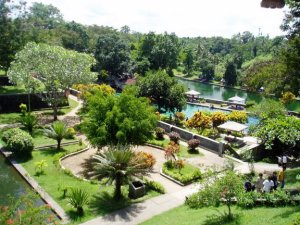
In 1727, King Anak Agung Gede Ngurah Karang Asem as both a pleasure garden and place to worship Shiva built Narmada Garden, 11 kilometers east of Mataram. Its big pool is said to represent Segara Anakan, the Crater Lake on volcano Rinjani where they used to make offerings by throwing valuables into the water. As he became too old to make the pilgrimage up the 3,726-meter high mountain, he had Narmada made to represent the mountains and the lake. Near the pond is a place of worship and a spring whose water is believed to give dedicated pilgrims eternal youth.
Senggigi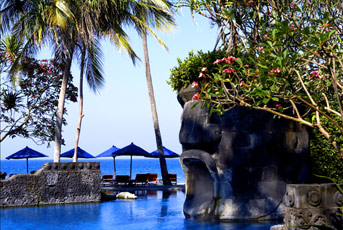
The roads which leaves Ampenan towards the north, passes two small mountains before it reaches a long, bow-shaped beach. On the mornings after moonless nights these hills offer the best view over the sea, which is scattered with small fishing boats with colorful sails, which return to the beach north of Ampenan. When the sunsets the fishermen leave the beach in one long line their lights create a nice play of lights, which can be seen from most hotels on Senggigi beach.
The first of the two small mountains, which are passed from Ampenan, named Batu Layar, contains the dedicated grave of one of the Islamic saints (wali), which spread Islam on Lombok. The local population prays near a shrine close to the road. It's possible to walk from the summit of the second mountain to the Balinese temple along Batu Bolong beach.
Batu Bolong Beach
Located 9 km from downtown Mataram, this beach has a huge rock with a hole in it. It is an ideal place which to see the majestic sunset from Lombok Strait. After sunbathing, relaxing and frolicking on this beautiful beach-front, try to stay till the end of the day to watch one of the most stunning sunsets you have ever seen when the sun slowly begins to disappear behind Mount Agung with incredibly flaming colors. A Hindu temple lies on top facing the Lombok Strait and beyond is the contour of majestic Mount Agung of Bali. Colorful and musical religious ceremonies are often held in this beautiful temple.
Lingsar Temple
This may be the only Hindu shrine in the world where both Hindus and Moslems come to worship. About 7 kilometers west of Narmada, it was built in 1714 and rebuilt in 1878 to symbolize harmony and unity between the Hindu Balinese and Moslem Sasak population of the area, especially those who adhere to Lombok's unique Wektu Telu school of Islam. The Balinese temple is built on higher ground, behind the Moslem section in the compound. In the lower yard is a spring in which pilgrims in the temple yard stage a mock battle between Hindus and Moslems, in which both parties hurl rice cakes at each other.
Mataram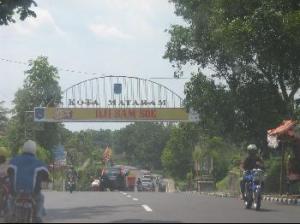
Mataram is the capital of Lombok. The town actually consists of four different towns Ampenan, Mataram, Cakranegara (Cakra) and Sweta. Ampenan has most of city sights, including Negeri Nusa Tenggara Barat museum, which gives a good overview of the culture of Lombok. Cakra is the best place for eating, sleeping and shopping. It also has the Water Palace, which is worth a visit and the largest temple of Lombok, Meru Purse. Mataram is the administrative centre and Sweta the transport connection of the whole island. As a center of government administration, Mataram has many large, impressive public buildings and substantial houses. The city also has transportation and shopping facilities. The main square is used for art exhibitions, theater, dance, and wayang kulit (puppet theater) performances. In other parts of Mataram, there are a variety of old-style markets and neighborhoods featuring traditional craftwork like basketware and gold- and silver-threaded sarongs, or wraparound garments.
Kuta Beach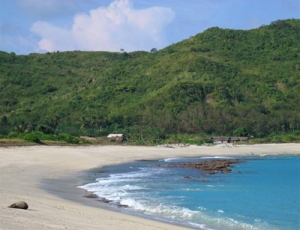
The best-known place on the south coast is Lombok's Kuta Beach (Sometime spelt 'Kute Beach'), a magnificent stretch of white sand and blue sea with rugged hills rising around it, but not much else. Plenty of good waves break on the reefs around here - many supposedly “Secret”. There are lefts and rights in the bay in front of Kuta, and some more on reefs east of Tanjung Aan. Local boatman will take you out for a few thousands rupiah. Go about seven km east of Kuta to fishing in Gerupuk village, where there are several potential breaks on the reefs at the entrance of Gerupuk Bay. Again access is by local fishing boat. There's more breaks further east and west, from Blongas to Serewi. Also known as Putri Nyale Beach, Kuta on the south coast of central Lombok is one of the most scenic and unspoiled beaches in this part of Indonesia. From Kuta to Tanjung Aan five km away, it is an unbroken stretch of clean white sand on the Indian Ocean. It is safe for bathing and swimming. Further to the west are the surfers and wind surfer's beaches. Each year, on the 19th day of the tenth month of Sasak lunar calendar on February or March when Nyale fish come to the sea's surface, Kuta Beach is the site of great festivities. Fishermen sail out to sea while young men and women gather along the beach to join in the merrymaking, tease each other and perhaps meet to build a more lasting relationship.
Gili Air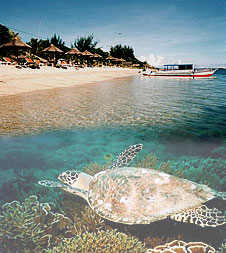
Gili Air is the nearest Gili to Lombok. It is also the most populated and you will find more trees there than the other Gili's. The local inhabitants are: Sasak, Mandar, Bugis and Makassar. You can find their different unique culture from Lombok and wonderful beaches. Many of the older generation still make their living as boatmen, fisherman and farming coconuts. There are only a few number of 2-3 stars hotels (rooms with air conditioning, swimming pool, TV etc) on Gili Air. Most of the places to eat and stay are in south and east side of the island (near the jetty). You can find many home stays or budget accommodation on this island. Not much things happening for the last 3-5 years. One of the first dive schools (The Reef seeker) is no longer operate from Gili Air. They have moved to Flores. Returning guests are what they expect to come. Most accommodation are locally owned and managed, while a few of the up market hotels own and managed by foreign investors. You can go from one island to another by joining Gili Island's hoping boat (depart twice a day). People here are friendlier than on Gili Trawangan. There are also a few places to stay around the north and south west coast in quieter atmosphere.
Gili Meno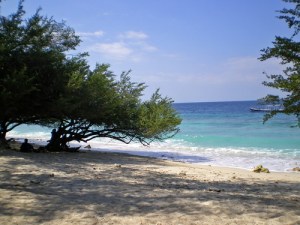
Gili Meno, the middle island, the smallest of the three Gili's and it is the quietest with fewer tourists. A great escape for honeymooners or someone who wants to get away from it all. A special feature of the island is the salt lake and spectacular dive sites such as, Meno Wall, Sea Turtle Point, and Blue Coral Point. The beach on eastern part of the island is very nice and there's snorkeling just offshore and further north. In the past Meno was known to have lots of mosquitoes but steps have been taken to control it. Still the best time to visit the island is during dry season.
Gili Trawangan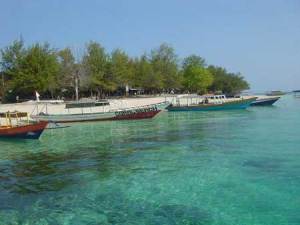
Gili Trawangan, the most popular island of the Gili's. Just kick back and enjoy the sun, nightly beach parties and sea. The main stripe is full of accommodations, restaurants, and dive shops. If you are seeking a quieter place to stay, there are bungalows in the north. This Island is also known as "Party Island", where mostly young European found them "Lost In Paradise". With spectacular sunrises over Lombok's Mount Rinjani volcano and breathtaking sunsets that illuminate Bali's towering Mount Agung volcano, together with warm hospitality of Gili Trawangan residents, it's not surprising that most visitors end up staying longer than originally plan. Snorkeling off the shore, sunbathing, swimming, or join any dive trips with any dive operators, which colored the lines. There are quality dive schools available to cater the needs of tourists, offering complete range of PADI courses, as well as Fun Dives for those already certified. By night, the waterfront comes to life as various foreign and locally restaurants and bars start to fire up, with fresh snapper, grouper and tuna, cooked over charcoal flames, readily available.
Bayan
Bayan: Center of the Wetu Telu Bayan is located five km southeast of Anyar. Just before the village a road to the south runs to Batu Koq and Senari, starting points for the ascend of Mount Rinjani. The area has several lodges. From here it's less than one hour walking to the high fall of Sendang Gile, from which the vast fields east of the village get their water.
Tidak ada komentar:
Posting Komentar